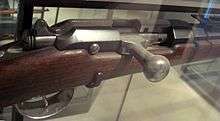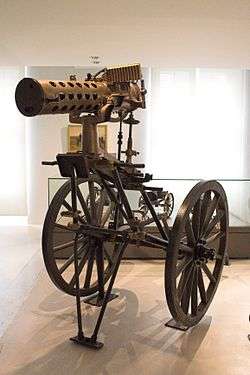Fusil Gras mle 1874
| Gras M80 Model 1874 rifle Fusil Gras M80 Modèle 1874 | |
|---|---|
|
Fusil Gras M80 1874 | |
| Type | Bolt-action rifle |
| Place of origin | France |
| Service history | |
| In service | 1874–1886 (France) |
| Used by |
Chile France Kingdom of Greece Monaco |
| Wars |
French colonial expeditions Sino-French War War of the Pacific Chilean Civil War of 1891 Thousand Days' War Greco-Turkish War (1897) Balkan Wars World War I Greco-Turkish War (1919–22) Spanish Civil War World War II |
| Production history | |
| Designed | 1874 |
| Manufacturer | Manufacture d'armes de Saint-Étienne and Steyr |
| Specifications | |
| Weight | 4.15 kg (9.15 lb) |
| Length | 1305 mm (51.4 in) |
| Barrel length | 820 mm (32.3 in) |
|
| |
| Caliber | 11×59mmR [1] & 8×50mmR Lebel |
| Action | Bolt action |
| Feed system | Single shot, 10 round gravity hopper |
| Sights | Iron sights |
The Fusil Gras Modèle 1874 M80 was a French service rifle of the 19th century. The Gras used by the French Army was an adaptation to metallic cartridge of the Chassepot breech-loading rifle by Colonel Basile Gras.
Description
This rifle had a caliber of 11mm and used black powder centerfire cartridges that weighed 25 grams. It was a robust and hard-hitting weapon, but it had no magazine and so could only fire one shot after loading. It also had a triangular-shaped sword bayonet, known as the Model 1874 "Gras" sword bayonet. It was replaced by the Lebel rifle in 1886, the first rifle to use smokeless gunpowder. In the meantime, about 400,000 Gras rifles had been manufactured.
The metallic-cartridge Gras was manufactured in response to the development of the metallic cartridge designed by Colonel Boxer in 1866 (Boxer cartridge), and the British 1870 Martini-Henry rifle.[2] Those were soon emulated by the Germans with the 1871 Mauser.[2]
The Hellenic Army adopted the Gras in 1877, and it was used in all conflicts up until the Second World War. It became the favourite weapon of Greek guerrilla fighters, from the various revolts against the Ottoman Empire to the resistance against the Axis, acquiring legendary status. The name entered the Greek language, and grades (γκράδες) was a term colloquially applied to all rifles during the first half of the 20th century. It was manufactured by Manufacture d'armes de Saint-Étienne, one of several government-owned arms factories in France. However most of the Gras rifles (60,000) used by the Hellenic military were manufactured under licence by Steyr in Austria.
The Gras rifle was partly the inspiration for the development of the Japanese Murata rifle, Japan's first locally-made service rifle.
According to the Vietnamese historian Phạm Văn Sơn, a Vietnamese general in the Hương Khê uprising, named Cao Thắng (1864-1893), managed to copy the design of "a 1874 type fast-firing rifle of French". However, the Vietnamese version did not have a rifled barrel, and the range was limited.[3]
Users
-
 Chile during the War of the Pacific
Chile during the War of the Pacific -
.svg.png) Ethiopian Empire: the Gras was used by the Ethiopian Army[4]
Ethiopian Empire: the Gras was used by the Ethiopian Army[4] -
 France: due to firearm shortages in World War I, France converted 146,000 rifles to fire 8mm Lebel in 1914
France: due to firearm shortages in World War I, France converted 146,000 rifles to fire 8mm Lebel in 1914 -
.svg.png) Greece: the Gras was used by the Hellenic Army as late as 1941 in the Battle of Crete
Greece: the Gras was used by the Hellenic Army as late as 1941 in the Battle of Crete -
 Monaco
Monaco -
 Russian Empire: due to firearm shortages in World War I, the Russian Empire received Gras rifles from France[5][6] France sent 450,000 Gras rifles to Russia.[7]
Russian Empire: due to firearm shortages in World War I, the Russian Empire received Gras rifles from France[5][6] France sent 450,000 Gras rifles to Russia.[7] - Vietnam: Vietnamese insurgent of the Hương Khê uprising managed to produce the copy version of Fusil Gras mle 1874. The Vietnamese version did not have rifled barrel, though.
Gallery
 Fusil Gras M80 1874 breech portion
Fusil Gras M80 1874 breech portion Fusil Gras M80 Mle 1874 metallic cartridge
Fusil Gras M80 Mle 1874 metallic cartridge Fusil Gras modified in 1883 with 10 cartridge gravity hopper
Fusil Gras modified in 1883 with 10 cartridge gravity hopper R: 11mmx59.5R metallic cartridge for Fusil Gras mle 1874
R: 11mmx59.5R metallic cartridge for Fusil Gras mle 1874 1875 Gras Bayonet
1875 Gras Bayonet
See also
Notes
- ↑ http://members.nuvox.net/~on.melchar/11gras/index.html
- 1 2 The Tools of Empire by Daniel R. Headrick p.98
- ↑ Phạm Văn Sơn, Việt sử tân biên (quyển 5, tập trung). Tác giả tự xuất bản, Sài Gòn. 1963. p. 147
- ↑ Г. В. Цыпкин, В. С. Ягья. История Эфиопии в новое и новейшее время. М.: «Наука», 1989. стр. 217
- ↑ А.А. Игнатьев. Пятьдесят лет в строю. том 2 (кн. 4-5). М., 1989. стр.127
- ↑ "Во время первой мировой войны царская Россия испытывала недостаток в стрелковом вооружении, поэтому в армии кроме винтовок русского образца были также и иностранные - японские Арисака обр.1897 и 1905 гг., австро-венгерские Манлихера 1889 и 1895 гг., германские "88" и "98". Кроме этих винтовок использовались также и устаревшие образцы, стрелявшие патронами, снаряженными дымным порохом - Бердана № 2 образца 1870 г., Гра 1874 г., Гра-Кропачека 1874/85 г., Веттерли 1870/87 г."
А. Б. Жук. Энциклопедия стрелкового оружия: револьверы, пистолеты, винтовки, пистолеты-пулеметы, автоматы. М., АСТ — Воениздат, 2002. стр.587 - ↑ А. А. Маниковский. Русская армия в Великой войне: Боевое снабжение русской армии в мировую войну. М., 1937
External links
| Wikimedia Commons has media related to Fusil Gras M80 Modèle 1874. |
| Preceded by Chassepot Modèle 1866 |
French Army rifle 1874-1886 |
Succeeded by Lebel Modèle 1886 |

